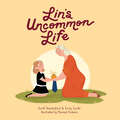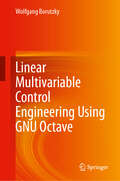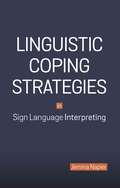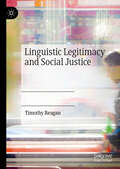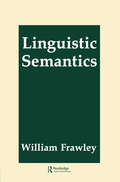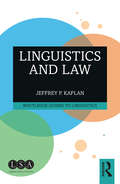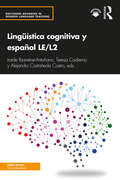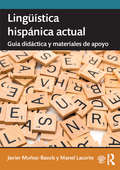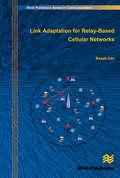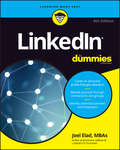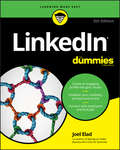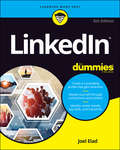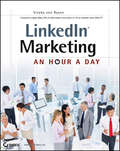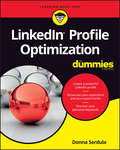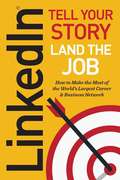- Table View
- List View
Lin's Uncommon Life
by Scott Shackelford Emily CastleElinor (Lin) Ostrom's life was an incredible journey. Being the first woman ever to win a Nobel Prize in Economics was an achievement of a lifetime. But it was just the culmination of a life spent struggling against the odds.Even while overcoming childhood hardships and a stutter and being denied opportunities because she was a woman, Lin never lost sight of the wonders around her and was always curious to learn more. Lin would teach generations of students the lessons she learned through a lifetime of research and dedication. As Lin said "little by little, bit by bit, family by family, so much good can be done on so many levels."Discover Lin's Uncommon Life, and let it be an inspiration to follow your own path. Small steps, taken one at a time, can lead you somewhere truly uncommon in the end.
Linear Multivariable Control Engineering Using GNU Octave
by Wolfgang BorutzkyThis textbook presents an in-depth introductory survey of several fundamental advanced control concepts and techniques all ranging from modern ideas. The book emphasizes ideas, an understanding of key concepts, methodologies, and results. In line with this, the book addresses master’s students in the overlap of engineering and computer science as well as engineers working in various application fields and interested in useful control techniques and less in system theories appealing from a mathematical point of view. The book aims to show what methods and results learned for single-variable systems are also applicable to multivariable systems, what is different and why. The structured text covers a broad spectrum of topics from decentralized control to the use of linear matrix inequalities (LMIs). Methods and results are illustrated by many examples and using free, open source mathematical software, predominately GNU Octave. In some cases, the free mathematical software package Scilab is also used. The book features exercises and examples throughout.
Lineare Kirchhoff-Netzwerke: Grundlagen, Analyse und Synthese
by Reiner ThieleDas Buch vermittelt ausgehend von den Grundlagen der Netzwerk-Theorie neuartige Analyse- und Syntheseverfahren für lineare zeitinvariante Kirchhoff-Netzwerke. Hierzu verwendet der Autor als Elementarnetzwerke gewöhnliche Widerstände, Kondensatoren und Spulen sowie die sogenannten pathologischen Unternetzwerke Nullator, Norator und Nullor. Der Nullor besteht dabei aus einem Nullator und einem Norator, wird hinsichtlich seines Klemmenverhaltens durch die Belevitch-Darstellung beschrieben und näherungsweise durch einen Operationsverstärker realisiert. Zur Analyse oder Synthese erfolgt die Zerlegung in realisierbare Unternetzwerke mit dem Verfahren der Singulärwert-Zerlegung von Matrizen. Außerdemzeigt Reiner Thiele, wie durch die Applikation vonKlemmen-Äquivalenzenpraxisrelevante elektrische oder elektronische Schaltungen entstehen.
Lineare Kirchhoff-Netzwerke: Grundlagen, Analyse und Synthese
by Reiner ThieleDas Buch vermittelt ausgehend von den Grundlagen der Netzwerk-Theorie neuartige Analyse- und Syntheseverfahren für lineare zeitinvariante Kirchhoff-Netzwerke. Hierzu verwendet der Autor als Elementarnetzwerke gewöhnliche Widerstände, Kondensatoren und Spulen sowie die sogenannten pathologischen Unternetzwerke Nullator, Norator und Nullor. Der Nullor besteht dabei aus einem Nullator und einem Norator, wird hinsichtlich seines Klemmenverhaltens durch die Belevitch-Darstellung beschrieben und näherungsweise durch einen Operationsverstärker realisiert. Zur Analyse oder Synthese erfolgt die Zerlegung in realisierbare Unternetzwerke mit dem Verfahren der Singulärwert-Zerlegung von Matrizen. Außerdem zeigt Reiner Thiele, wie durch die Applikation von Klemmen-Äquivalenzen praxisrelevante elektrische oder elektronische Schaltungen entstehen.
Lineare Kirchhoff-Netzwerke: Grundlagen, Analyse und Synthese
by Reiner ThieleDas Buch vermittelt ausgehend von den Grundlagen der Netzwerk-Theorie neuartige Analyse- und Syntheseverfahren für lineare zeitinvariante Kirchhoff-Netzwerke. Hierzu verwendet der Autor als Elementarnetzwerke gewöhnliche Widerstände, Kondensatoren und Spulen sowie die sogenannten pathologischen Unternetzwerke Nullator, Norator und Nullor. Der Nullor besteht dabei aus einem Nullator und einem Norator, wird hinsichtlich seines Klemmenverhaltens durch die Belevitch-Darstellung beschrieben und näherungsweise durch einen Operationsverstärker realisiert. Zur Analyse oder Synthese erfolgt die Zerlegung in realisierbare Unternetzwerke mit dem Verfahren der Singulärwert-Zerlegung von Matrizen. Außerdem zeigt Reiner Thiele, wie durch die Applikation von Klemmen-Äquivalenzen praxisrelevante elektrische oder elektronische Schaltungen entstehen.
Lines in the Sand: Collected Journalism
by Adrian Gill'By miles the most brilliant journalist of our age' Lynn Barber'A golden writer' Andrew MarrA. A. Gill was rightly hailed as one of the greatest journalists of our time. This selection of some of his recent pieces, which he made himself before his untimely death, spans the last five years from all corners of the world. It shows him at his most perceptive, brilliant and funny.His subjects range from the controversial - fur - to the heartfelt - a fantastic crystallisation of what it means to be European. He tackles life drawing, designs his own tweed, considers boyhood through the prism of the Museum of Childhood, and spends a day at Donald Trump's university. In his final two articles he wrote with characteristic wit and courage about his cancer diagnosis - 'the full English - and the limits of the NHS. But more than any other subject, a recurring theme emerges in the overwhelming story of our times: the refugee crisis. In the last few years A. A. Gill wrote with compassion and anger about the refugees' story, giving us both its human face and its appalling context. The resulting articles are journalism at its finest and fiercest.
Linguaphile: A Life of Language Love
by Julie SedivyA celebration of the beauty and mystery of language and how it shapes our lives, our loves, and our world.If there is one feature that defines the human condition, it is language: written, spoken, signed, understood, and misunderstood, in all its infinite glory. In this ingenious, lyrical exploration, Julie Sedivy draws on years of experience in the lab and a lifetime of linguistic love to bring the discoveries of linguistics home, to the place language itself lives: within the yearnings of the human heart and amid the complex social bonds that it makes possible.Linguaphile: A Life of Language Love follows the path that language takes through a human life—from an infant’s first attempts at sense-making to the vulnerabilities and losses that accompany aging. As Sedivy shows, however, language and life are inextricable, and here she offers them together: a childish misunderstanding of her mother’s meaning reveals the difficulty of relating to other minds; frustration with “professional” communication styles exposes the labyrinth of standards that define success; the first signs of hearing loss lead to a meditation on society’s discomfort with physical and mental limitations.Part memoir, part scientific exploration, and part cultural commentary, this book epitomizes the thrills of a life steeped in the aesthetic delights of language and the joys of its scientific scrutiny.
Linguistic Coping Strategies in Sign Language Interpreting
by Jemina NapierThis ground-breaking work, originally published 15 years ago, continues to serve as the primary reference on the theories of omission potential and translational contact in sign language interpreting. In the book, noted scholar Jemina Napier explores the linguistic coping strategies of interpreters by drawing on her own study of the interpretation of a university lecture from English into Australian Sign Language (Auslan). A new preface by the author provides perspective on the importance of the work and how it fits within the scholarship of interpretation studies. The concept of strategic omissions is explored here as a tool that is consciously used by interpreters as a coping strategy. Instead of being a mistake, omitting part of the source language can actually be part of an active decision-making process that allows the interpreter to convey the correct meaning when faced with challenges. For the first time, Napier found that omission potential existed within every interpretation and, furthermore, she proposed a new taxonomy of five different conscious and unconscious omission types. Her findings also indicate that Auslan/English interpreters use both a free and literal interpretation approach, but that those who use a free approach occasionally switch to a literal approach as a linguistic coping strategy to provide access to English terminology. Both coping strategies help negotiate the demands of interpretation, whether it be lack of subject-matter expertise, dealing with dense material, or the context of the situation. Napier also analyzes the interpreters' reflections on their decision-making processes as well as the university students' perceptions and preferences of their interpreters' linguistic choices and styles. Linguistic Coping Strategies in Sign Language Interpreting is a foundational text in interpretation studies that can be applied to interpreting in different contexts and to interpreter training.
Linguistic Intermarriage in Australia: Between Pride and Shame
by Hanna Irving TorshThis book examines the experiences of couples with different language backgrounds and different cultural origins as they negotiate love, partnership and parenting. It is based on the author’s doctoral research into the attitudes and experiences of the English-speaking background (ESB) partners of non-English-speaking background (NESB) migrants in Sydney, Australia. In particular, it seeks to understand how these English speakers negotiate being in a romantic relationship with someone who has a different first language. It explores how those from an ESB reconcile the negative perspectives of Anglophone culture towards “other” languages, with their desire to be a good partner who respects the linguistic differences in their relationship. The book is organised into six chapters, which move from a focus on the language of the individual, to the languages of the couple, and then to the wider family. The main finding is that although ESB partners had very different beliefs and attitudes towards language learning to their migrant partners, they attempted to compensate for these differences in various ways. It will be of particular interest to students and scholars in the fields of language education, minority languages, and language policy and planning.
Linguistic Legitimacy and Social Justice
by Timothy ReaganThis book examines the nature of human language and the ideology of linguistic legitimacy – the common set of beliefs about language differences that leads to the rejection of some language varieties and the valorization of others. It investigates a broad range of case studies of languages and dialects which have for various reasons been considered 'low-status' including: African American English, Spanglish, American Sign Language, Yiddish, Esperanto and other constructed languages, indigenous languages in post-colonial neo-European societies, and Afrikaans and related language issues in South Africa. Further, it discusses the implications of the ideology of linguistic legitimacy for the teaching and learning of foreign languages in the US. Written in a clear and accessible style, this book provides a readable and pedagogically useful tool to help readers comprehend the nature of human language, and the ways in which attitudes about human language can have either positive or negative consequences for communities and their languages. It will be of particular interest to language teachers and teacher educators, as well as students and scholars of applied linguistics, intercultural communication, minority languages and language extinction.
Linguistic Response to the Taboo of Death in Egyptian Arabic
by Magdalena ZawrotnaThe work presents a study of the linguistic and pragmatic response to the taboo of death in Egypt. The analysis leads the author to the conclusion that the experience of death in Egyptian society is mediated by religion. The reaction to death announcements includes a number of strategies to protect both the author of the utterance and its recipient against the effects of the taboo related to this topic. The most important feature of the studied communication is formulaicity, which is at the same time the central idea and the methodological frame of the work presented here.The discourse analyzed here fits within the Arab-Muslim rhetorical framework. In the daily utterances of the Egyptians, divine agency is believed to be constantly present, which is attested in numerous ritual practices. As part of the quantitative study and the structural analysis of the material, a pattern was distinguished in which individual types of formulas occur in their fixed places and a specific order. Qualitatively, many of the statements in the material are strongly emotional. To enhance the pragmatic effect, phrases are combined with each other, repetitions, prayers, poetic attempts and quotes from the Quran/ Hadith appear. Most of the phrases used in response to the taboo of death are prefabricated items recalled from memory almost automatically. Further analysis proposes to look at the formulae in the context of taboo and strong emotions related to it. Using formulaic sequence instead of generating novel language enables. the author of the utterance to convey emotional support to the suffering person and, at the same time, eliminates ambiguity. The methodology proposed here offers a new insight into the language of everyday communication, through the lens of its pragmatic usefulness and linguistic etiquette, taking into account the cultural framework in which the analyzed utterances are performed.
Linguistic Semantics
by William FrawleyThis volume is a comprehensive, up-to-date, and readable introduction to linguistic meaning. While partial to conceptual and typological approaches, the book also presents results from formal approaches. Throughout, the focus is on grammatical meaning -- the way languages delineate universal semantic space and encode it in grammatical form. Subjects covered by the author include: the domain of linguistic semantics and the basic tools, assumptions, and issues of semantic analysis; semantic properties of entities, events, and thematic roles; language and space; tense, aspect, and the internal structure and temporal ordering of events; modality, negation, and the epistemology of the speaker; and modification and attribution. In contrast to most current treatments of semantics, this book is accessible to the beginning student of semantics and linguistics and also useful to the advanced practitioner. A textbook and reference work in a single volume, it can be used in a number of disciplines: psychology, computer science, and anthropology as well as linguistics.
Linguistics and Law (Routledge Guides to Linguistics)
by Jeffrey P. KaplanLinguistics and Law offers a clear and concise introduction to making sense of the law through linguistics. Drawing on lexical semantics, syntax, and pragmatics to interpret both written and spoken laws, this book: addresses how to interpret legal documents such as contracts, statutes, constitutional provisions and trademarks; provides thorough analyses of "language crimes" including solicitation, perjury, defamation, and conspiracy, as well as talk between police and criminal suspects; analyzes the Miranda warning in depth; tackles the question of whether there is a "language" of the law; draws on real-life case studies to aid understanding. Written in an approachable, conversational style and aimed at undergraduate students with little or no prior knowledge of linguistics or law, this book is essential reading for those approaching this topic for the first time.
Linguistics for Translators
by Juliane House Ali AlmannaThis engaging and accessible textbook, by two leading experts, is a carefully crafted introduction to linguistics for translators, students, and researchers of translation. Starting with basic concepts and gradually moving readers to the central questions in different branches of linguistics, examples are drawn from English and many other languages, including German, Arabic, Kurdish, Swahili, French, and Chinese. The key areas of linguistics are covered from morphology and syntax to semantics, pragmatics, discourse analysis, stylistics, sociolinguistics, and cognitive linguistics. Striking a balance between theoretical developments and empirical investigation, readers gain both a comprehensive overview of linguistics and how it informs their work in translation and learn how to argue for analysis and annotate their own answers and translations academically. Each chapter provides the reader with an overview outlining the main points and technical words used in the chapter as well as illustrative examples, recommended readings, and resources and activities to test knowledge. This is the ideal textbook for undergraduate and postgraduate students of translation in Translation Studies, Linguistics, and Modern languages.
Lingüística cognitiva y español LE/L2 (Routledge Advances in Spanish Language Teaching)
by Iraide Ibarretxe-Antuñano Teresa Cadierno Alejandro Castañeda CastroLingüística cognitiva y español LE/L2 constituye una valiosa aportación al estudio de la adquisición y la enseñanza del español LE/L2 desde la perspectiva teórica de la lingüística cognitiva. Se trata de la primera obra escrita en español en la que se ofrece una introducción a la lingüística cognitiva y su aplicación didáctica a la enseñanza del español LE/L2 desde una óptica internacional. Combina una orientación teórico-práctica que incluye diferentes estudios empíricos con pautas para ayudar a los profesores de español a integrar la lingüística cognitiva en la enseñanza de la lengua. Características principales: Una estructura homogénea y facilitadora de la lectura de los distintos capítulos que sirve para integrar contenidos lingüísticos y gramaticales desde un punto de vista cognitivo; Cuestiones clave en la enseñanza del español LE/L2 desde la óptica de la lingüística cognitiva: aspectos controvertidos de gramática, el desarrollo de la competencia metafórica, el aprendizaje del léxico, la influencia de la lengua materna, el foco en la forma, el uso de la traducción pedagógica; Pautas y sugerencias para aplicar la lingüística cognitiva en la enseñanza de la lengua, así como futuras vías de investigación; Una selección de imágenes, gráficos e ilustraciones para facilitar la comprensión de los temas y conceptos que se abordan en el volumen; Un glosario bilingüe (español e inglés) de términos clave para que cualquier lector pueda familiarizarse con los conceptos fundamentales de la lingüística cognitiva. Escrito en español, de manera clara y accesible, y con abundantes ejemplos, Lingüística cognitiva y español LE/L2 es una obra de referencia para docentes de español como LE/L2, estudiantes graduados y formadores de profesores, así como para cualquier persona que desee adquirir una perspectiva actual sobre las principales aportaciones teóricas y prácticas de la lingüística cognitiva a la enseñanza y el aprendizaje de segundas lenguas.
Lingüística hispánica actual: guía didáctica y materiales de apoyo
by Manel Lacorte Javier Munoz-BasolsLingüística hispánica actual provides step-by-step instructions on how to plan, design, and teach introductory Hispanic Linguistics courses. It is a versatile resource, which can be used in conjunction with Introducción a la lingüística hispánica actual: teoría y práctica. It contains an answer key for all the activities in the main textbook. It also includes additional activities, with clear and accessible explanations for students and instructors, and can accompany other existing texts and courses on Hispanic Linguistics. Features include: • A comprehensive selection of materials which gradually introduce students to the main areas of Hispanic Linguistics: General Linguistics, Phonology and Phonetics, Morphology, Syntax, Semantics and Pragmatics, History of the Spanish Language, Language Variation, and Second Language Acquisition and Language Teaching. • A wide range of carefully-crafted classroom and homework activities, essay questions and research projects to engage students and enrich their learning of Hispanic Linguistics. • Detailed guidance on how to successfully implement each activity in the classroom, suggestions for how to expand and adapt activities for different needs, and a full annotated answer key for instructors to save time planning and implementing lessons. • An extensive bilingual glossary of terms for each of the disciplines covered in the guide helps teachers introduce key concepts and terms in the classroom. Lingüística hispánica actual provides a wealth of activities specially designed to make learning Hispanic Linguistics more dynamic and enjoyable for students.
Lingüística textual y enseñanza del español LE/L2 (Routledge Advances in Spanish Language Teaching)
by Javier de Santiago-Guervós; Lourdes Díaz Rodríguez; Javier Muñoz-BasolsLingüística textual y enseñanza del español LE/L2 ofrece una visión de conjunto teórico-práctica y actualizada de la Lingüística textual aplicada a la enseñanza del español como lengua extranjera y/o segunda, destinada especialmente a estudiantes graduados y a profesores en formación nativos y no nativos. El volumen, escrito por un elenco internacional de profesores-investigadores, presenta una visión actualizada y práctica de los géneros textuales más frecuentes en programaciones universitarias. Enmarcado por una síntesis actualizada de estudios e investigaciones en lingüística aplicada que recorre distintas perspectivas teóricas y metodológicas, recoge datos y propuestas procedentes de aulas de aprendizaje de español de distintos contextos internacionales. Su principal propósito es suscitar la reflexión teórico-práctica sobre los géneros discursivos y su papel en el aula, y ofrecer una descripción pormenorizada de los mismos para proporcionar al profesorado en formación, nativo y no nativo, recursos prácticos y propuestas didácticas que ejemplifican y guían de manera razonada cómo llevar al aula los distintos géneros textuales. Características principales: • Amplitud de aspectos de la lingüística textual y géneros discursivos abordados enteramente para el español LE/L2 y en español. • Estructuración homogénea de los capítulos que facilita la lectura y da coherencia al conjunto. Atención a géneros escritos y orales desde una perspectiva teórico-práctica que puede inspirar nuevas investigaciones. Atención a la diversidad geolectal del español, a los contextos en que este es L2 (Europa, EEUU) y a la de sus aprendices (hablantes de herencia, L2, LE). Orientado a la aplicación práctica y docente en la clase de L2/LE, cada capítulo dedicado a un género incluye consejos, pautas o actividades para el aula. Incluye temática actual en lingüística textual y aprendizaje de lenguas: escritura académica, divulgación científica, textos jurídicos, aprendizaje mediado por ordenador o el lenguaje de las redes. Capítulos bien fundamentados teórica y bibliográficamente, con sólido respaldo de datos empíricos procedentes de corpus, bien contextualizados. Aborda los aspectos teóricos tradicionales relativos al estudio de la tipología textual y los desafíos metodológicos que afronta el profesor al llevar al aula los distintos géneros discursivos. La presente obra presenta, en un solo volumen, una visión actualizada y práctica de los tipos textuales y géneros discursivos de uso más frecuente desde una perspectiva teórico-práctica: presentación, descripción y puesta en práctica es un esquema de trabajo directo y enormemente útil para su aplicación en el aula. El ámbito internacional en el que se mueven los autores le da una amplitud nunca antes recogida en una obra de lingüística textual. Todo ello hace de Lingüística textual y enseñanza del español LE/L2 una obra de consulta obligada para docentes de español como LE/L2, para estudiantes graduados y formadores de profesores, así como para cualquier persona que desee adquirir una perspectiva actual sobre lingüística textual, géneros discursivos y enseñanza e investigación en español nativo y no nativo.
Link Adaptation for Relay-Based Cellular Networks
by Basak CanCover TextLink Adaptation for Relay-Based Cellular Networks focuses on the implementation of various link adaptation methods in OFDM(A) (Orthogonal Frequency Division Multiplexing/Multiple Access)?Time Division Duplex (TDD) based two-hop cellular networks. The analysis and design consider infrastructure based relays. New link adaptive transmission methods which dynamically select the channel coding, modulation, forwarding, relaying mechanisms and the packet size have been designed and evaluated for such networks. The selection among various schemes is based on maximizing the end-to-end throughput.This book provides a channel adaptive scheduler which considers the multiplexing loss caused by the two-phase nature of wireless relaying. The scheduler dynamically schedules the users on the frequency-time radio resources with efficient Modulation and Coding Schemes (MCS)s selected by Adaptive Modulation and Coding (AMC). Relaying is used only if it can provide throughput enhancement. The guidelines for efficient deployment of infrastructure based relay terminals are given. For the two-hop cellular communication systems, the system level performance of various cooperative diversity schemes has been investigated with the scheduler developed and the relays efficiently deployed in the cell. This investigation for low mobility scenarios shows that, a simple cooperative diversity scheme that dynamically chooses the best scheme among direct transmission and two-hop conventional relaying is a promising choice when compared to various more complex cooperative diversity schemes.In this book, a hop adaptive Medium Access Control (MAC)-Protocol Data Unit (PDU) size optimization is proposed for wireless relay networks.
Linked: Conquer LinkedIn. Get Your Dream Job. Own Your Future.
by Omar Garriott Jeremy SchifelingThe LinkedIn insider&’s guide to how the new job search really works—and how to make it work for you. No one disputes that LinkedIn is the world&’s biggest job market. So it&’s about time that someone with the inside scoop explained how to make the most of it. Here, from two LinkedIn experts and former employees, is the definitive guide that demystifies the massive site and gives every reader—from the newly minted college graduate to the midlife career-changer—the most important strategies to win the modern job search game. Clear, lively, and decidedly practical, Linked shows how to burnish your personal brand so recruiters come to you. Tap the power of the network effect and turn anyone into an invaluable referral. Think like employers and focus your profile to get noticed, get considered, and get hired. And game both the search algorithm and Applicant Tracking Systems used by nearly every employer in every economic sector. The result: not just a great job, but the future of your dreams.
LinkedIn For Dummies
by Joel EladDon't be left out--link up with this fully updated introduction to the Internet's hottest professional networking toolWith more than 225 million members from over 200 countries and territories worldwide, LinkedIn.com is an unbeatable self-marketing tool. LinkedIn For Dummies teaches you how to make the most of your LinkedIn.com profile and build connections and relationships within the world's largest professional network. This thorough introduction covers the latest LinkedIn features and how to use this valuable networking tool.Learn how LinkedIn helps you manage relationships and networks, handle recommendations, showcase your skills and endorsements, import contacts, follow thought leaders, cultivate sales leads, find investors, market yourself, and more.Provides valuable tips and explanations to help you build your profile, develop your network, manage invitations, request and write recommendations, and get involved in LinkedIn groupsCovers new and improved LinkedIn tools such as endorsements, people follow, company pages, groups, mobile apps, InMail, and LinkedIn TodayAnswers frequently asked LinkedIn and job searching questions with the clear and helpful style expected of For Dummies booksConnections have never been more vital to a successful career, and LinkedIn For Dummies is here to make sure you don't miss out on your next big opportunity!
LinkedIn For Dummies
by Joel EladMake LinkedIn your number one professional branding tool LinkedIn is the premiere social network for professionals looking to discover new opportunities, enhance personal branding, connect with other professionals, and make career advancements. With LinkedIn For Dummies, you’ll have step-by-step instructions on how to take advantage of the latest tools and features to do all of this and more. This book will teach you how to create an attractive profile that employers will notice, as well as ways to expand your network by making connections around the globe. You'll also learn how to best navigate the new user interface, write recommendations, take a course with LinkedIn Learning, and conduct your job search. Create an appealing, detailed profile Establish your credibility and personal brand Connect with employers and find jobs Request and write recommendations Whether you’re one of LinkedIn’s 500 million global members or brand new to the site, this authoritative resource helps you get the most out of the world’s largest professional network.
LinkedIn For Dummies
by Joel EladBrand yourself like a pro on LinkedIn LinkedIn multiplies what you know by the power of who you know to deliver the number one social platform for business professionals and new job seekers. LinkedIn For Dummies shows LinkedIn newcomers the best ways to discover new opportunities, enhance their personal brand, network with other professionals, and give an exponential boost to their career. Consider this book a passport to help you connect more successfully with many of LinkedIn’s 660+ million members in over 200 countries, as well as an expert guide to the platform’s tools and features and the proven tactics that get you noticed. In this friendly, all-access introduction to the LinkedIn scene, entrepreneurship guru Joel Elad clues you in on the essentials. Get the latest insight on how to create an attractive profile that will make employers give you a second glance as well as techniques for making useful connections across the globe. In no time at all you’ll also be right at home with the profile user interface and getting busy with adding content, searching for career opportunities, and, if you’re looking to hire for your company, recruiting top candidates. Build your personal brand and market it Sell yourself by highlighting skills, awards, and endorsements Get connected with LinkedIn groups Manage and make introductions via InMail Relationships matter: LinkedIn For Dummies gives you the online social skills to turn six degrees of separation into the colleagues, mentors, and friends who will transform your career—and your life.
LinkedIn Marketing: An Hour a Day
by Viveka Von RosenA step-by-step guide for succeeding on the for ''business'' social media network LinkedIn Marketing: An Hour a Day helps you create, customize, and optimize a presence on LinkedIn, the world's largest social network for professionals. In this detailed, step-by-step book, LinkedIn expert Viveka von Rosen reveals how to use this powerful platform to ensure that you or your company get noticed by the right audience. Discover previously undocumented tips and tricks for community growth and management, including how to best use Groups, events, and other LinkedIn features and applications. Offers a complete resource for anyone who wants to market and recruit on the world's largest professional network Features hands-on tutorials, case studies, examples, tips, and tactics Reveals how to monitor and maintain a vibrant LinkedIn presence Includes effective tactics for recruiters, job seekers, and entrepreneurs, as well as legal, real estate, and nonprofit professionals Incorporates an exploration of the LinkedIn advertising platform, API, and mobile platform This soup-to-nuts guidebook for tackling every stage of the LinkedIn process ensures your online presence will get noticed.
LinkedIn Profile Optimization For Dummies
by Donna SerdulaOptimize your LinkedIn profile--and get results Your LinkedIn profile is essentially a platform to shape how others see you, highlight your abilities, products, or services, and explain how your work impacts lives. Yet many people simply copy and paste their resume and expect job offers and networking opportunities to start rolling in--but that isn't how it works. LinkedIn Profile Optimization For Dummies shows you how to create a profile that enhances your personal brand, controls how others see you, and shapes a successful future for your career. Whether your goal is job search, branding, reputation management, or sales, people are Googling you--and your LinkedIn profile is more often than not their first point of contact. With a focus on who you are, the value you deliver, and the culture you cultivate, the profile you'll create with the help of this guide will make that first connection a positive one--giving you a better chance to see results. Create a powerful LinkedIn profile Discover your personal keywords Showcase your experience and accomplishments Be seen on the world's largest professional social network You never get a second chance to make a great first impression, and LinkedIn Profile Optimization For Dummies helps to ensure you're presenting yourself in the best possible light.
LinkedIn: Tell Your Story, Land the Job
by Jeff Norman<p>Meet the World's Largest Career and Networking Site: LinkedIn <p>LinkedIn is dominating the world of business-based networking, yet many of its users don't know how to make the most of it, while others are hesitant to join yet another social network. Whether you're a job seeker, an employer in search of new talent, or a business looking to boost your visibility, make LinkedIn your social network of choice, this book your guide. <p><i>LinkedIn: Tell Your Story, Land the Job</i> will help you: <p> <li>Learn tips and tricks for building a strong LinkedIn profile, optimized for discovery <li>Write a concise professional summary, gather endorsements and recommendations, and highlight your skills <li>Create a virtual hub for current and potential employees and customers <li>Take advantage of LinkedIn's Company Pages to improve your visibility <li>Dig deeper into LinkedIn's offerings, by getting the most out of introduction requests, advanced search, media tools, and professional groups <li>Explore the pros and cons of the free vs. paid versions of LinkedIn</li> <p> <p>Dust off your LinkedIn Profile and make it shine with this visual, easy-to-follow handbook.</p>
